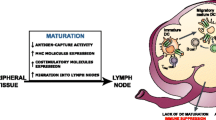Abstract
Dendritic cells (DCs), the most prevalent antigen-presenting cell in vivo, had been widely characterized in the last three decades. DCs are present in almost all tissues of the body and play cardinal roles in recognition of microbial agents, autoantigens, allergens and alloantigen. DCs process the microbial agents or their antigens and migrate to lymphoid tissues to present the antigenic peptide to lymphocytes. This leads to activation of antigen-specific lymphocytes. Initially, it was assumed that DCs are principally involved in the induction and maintenance of adaptive immune responses, but now it is evident that DCs also have important roles in innate immunity. These features make DCs very good candidates for therapy against various pathological conditions including malignancies. Initially, DC-based therapy was used in animal models of cancers. Data from these studies inspired considerable optimism and DC-based therapies was started in human cancers 8 years ago. In general, DC-based therapy has been found to be safe in patients with cancers, although few controlled trials have been conducted in this regard. Because the fundamentals principles of human cancers and animal models of cancers are different, the therapeutic efficacy of the ongoing regime of DC-based therapy in cancer patients is not satisfactory. In this review, we covered the various aspects that should be considered for developing better regime of DC-based therapy for human cancers.
Similar content being viewed by others
References
Akbar, S.M.F., Murakami, H., Horiike, N., Onji, M., 2004a. Dendritic cell-based therapies in the bench and the bed sides.Curr Drug Targets Allergy Infection,3:305–310.
Akbar, S.M.F., Furukawa, S., Onji, M., Muarta, Y., Niya, T., Kanno, S., Murakami, H., Horiike, N., 2004b. Safety and efficacy of hepatitis B surface antigen-pulsed dendritic cells in human volunteers.Hepatol Res,29: 136–141.
Byrne, S.C., Hallyday, G.M., 2002. Dendritic cells making progress with cancer vaccination.Immunol Cell Biol,80:520–530.
Kumagi, T., Akbar, S.M.F., Horiike, N., Onji, M., 2003. Increased survival and decreased tumor size due to intratumoral injection of ethanol followed by administration of immature dendritic cells.Int J Oncol,23:945–955.
Onji, M., 2004. Dendritic Cells in Clinics. Springer, Tokyo, Japan.
Schuler, G., Schulre-Thurner, B., Steinman, R.M., 2003. The use of dendritic cells in cancer immunotherapy.Curr Opin Immunol,15:138–147.
Steinman, R.M., 1991. The dendritic cell system and its role in immunogenicity.Annu Rev Immunol, 9:271 -296.
Steinman, R.M., Colin, Z.A., 1973. Identification of a novel cell type in the peripheral lymphoid organs of mice. 1. Morphology, quantification, tissue distribution.J Exp Med,137:1142–1162.
Steinman, R.M., Dhopadkar, M., 2001. Active immunization against cancer and dendritic cells; the near future.Int J Cancer,94:459–473.
Author information
Authors and Affiliations
Corresponding author
Rights and permissions
About this article
Cite this article
Onji, M., Akbar, S.M.F. On dendritic cell-based therapy for cancers. J Zheijang Univ Sci B 6, 1–3 (2005). https://doi.org/10.1631/jzus.2005.B0001
Received:
Revised:
Published:
Issue Date:
DOI: https://doi.org/10.1631/jzus.2005.B0001




